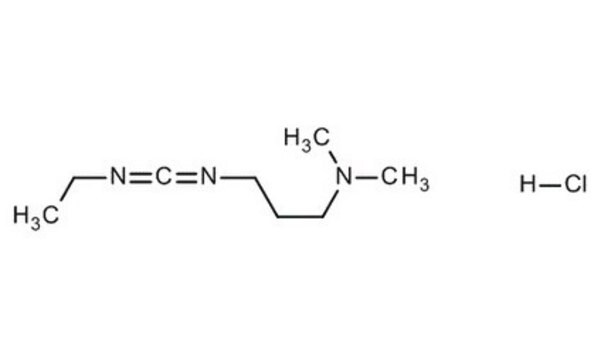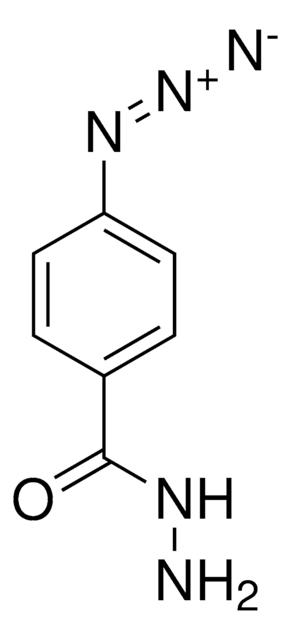39391
N-(3-Dimethylaminopropyl)-N′-ethylcarbodiimide
≥97.0% (T), for peptide synthesis
Synonim(y):
N-Ethyl-N′-(3-dimethylaminopropyl)carbodiimide, EDC, WSC
About This Item
Polecane produkty
product name
N-(3-Dimethylaminopropyl)-N′-ethylcarbodiimide, ≥97.0% (T)
Próba
≥97.0% (T)
Postać
liquid
przydatność reakcji
reaction type: Coupling Reactions
współczynnik refrakcji
n20/D 1.461
gęstość
0.877 g/mL at 20 °C (lit.)
Zastosowanie
peptide synthesis
temp. przechowywania
−20°C
ciąg SMILES
CCN=C=NCCCN(C)C
InChI
1S/C8H17N3/c1-4-9-8-10-6-5-7-11(2)3/h4-7H2,1-3H3
Klucz InChI
LMDZBCPBFSXMTL-UHFFFAOYSA-N
Powiązane kategorie
Opis ogólny
Zastosowanie
Hasło ostrzegawcze
Danger
Zwroty wskazujące rodzaj zagrożenia
Zwroty wskazujące środki ostrożności
Klasyfikacja zagrożeń
Acute Tox. 3 Dermal - Acute Tox. 4 Oral - Aquatic Acute 1 - Aquatic Chronic 1 - Eye Dam. 1 - Skin Corr. 1A - Skin Sens. 1A - STOT RE 2 Oral
Organy docelowe
Stomach,large intestine,lymph node
Kod klasy składowania
6.1A - Combustible acute toxic Cat. 1 and 2 / very toxic hazardous materials
Klasa zagrożenia wodnego (WGK)
WGK 3
Temperatura zapłonu (°F)
Not applicable
Temperatura zapłonu (°C)
Not applicable
Środki ochrony indywidualnej
Faceshields, Gloves, Goggles, type ABEK (EN14387) respirator filter
Certyfikaty analizy (CoA)
Poszukaj Certyfikaty analizy (CoA), wpisując numer partii/serii produktów. Numery serii i partii można znaleźć na etykiecie produktu po słowach „seria” lub „partia”.
Masz już ten produkt?
Dokumenty związane z niedawno zakupionymi produktami zostały zamieszczone w Bibliotece dokumentów.
Klienci oglądali również te produkty
Produkty
Collagen molecules play a critical role in tissue architecture and strength, and in cell-matrix interactions as insoluble ligands to regulate the diverse phenotypic activities of cells.
Nasz zespół naukowców ma doświadczenie we wszystkich obszarach badań, w tym w naukach przyrodniczych, materiałoznawstwie, syntezie chemicznej, chromatografii, analityce i wielu innych dziedzinach.
Skontaktuj się z zespołem ds. pomocy technicznej










